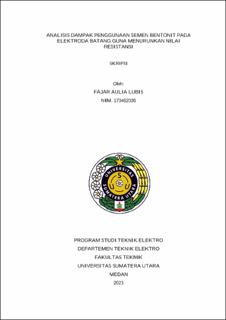| dc.description.abstract | One of the factors that must be considered is the operational reliability of the electrical system and the safety of living things around it, namely the grounding system for the electrical source, which is commonly known as the grounding system and earthing system. Both are interconnected systems, whose function is to transmit excess current or voltage which generally causes damage to electrical equipment and endangers the safety of living creatures in the surrounding area. The best ground resistance according to the PUIL 2007 standard is < 5 ohms for the grounding system and < 3 ohms for the grounding system for the electronic device frame. The value of soil resistance is influenced by several factors, including soil resistivity, soil moisture, soil mineral content and soil temperature. In this research, the soil media will be replaced with Bentonite Cement, each bentonite cement media having a diameter of 10 cm, 15 cm, 20 cm and 25 cm. Measurements were carried out using a single rod electrode using the three-point method. In this research, the results were obtained, namely measuring the best measured resistance of bentonite cement with a diameter of 25 cm with a humidity of 90% in the morning, afternoon and evening on the 3rd day with a value of 13.38 Ω compared to the original soil medium with a humidity of 50% of 19 .24Ω. Next, comparing the diameter variations of 10 cm, 15 cm, 20 cm and 25 cm, the measured resistance values were 18.53 Ω, 16.63 Ω and 14.53 Ω. Meanwhile, the comparison of the percentage reduction in the calculated resistivity during the day on the 3rd day was 30.54% compared to the resistivity of variations in diameters of 10 cm, 15 cm, and 20 cm, only 3.78%, 13.64%, 24.56 %. | en_US |


